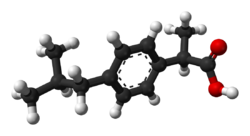
Back Ibuprofeen Afrikaans Ibuprofeno AN إيبوبروفين Arabic Ibuprofeno AST ایبوپروفن AZB Ібупрафэн BE-TARASK Ибупрофен Bulgarian आइबूप्रोफेन Bihari আইবুপ্রোফেন Bengali/Bangla པུ་རོ་ཧྥེན་ Tibetan
 (R/S)-ibuprofen | |
 (R)-ibuprofen | |
| Clinical data | |
|---|---|
| Pronunciation | /ˈaɪbjuːproʊfɛn/ ⓘ, /aɪbjuːˈproʊfən/, eye-bew-PROH-fən |
| Trade names | Brufen, others |
| Other names | isobutylphenylpropionic acid |
| AHFS/Drugs.com | Monograph |
| MedlinePlus | a682159 |
| License data | |
| Pregnancy category |
|
| Routes of administration | By mouth, rectal, topical, intravenous |
| Drug class | Nonsteroidal anti-inflammatory drug (NSAID) |
| ATC code | |
| Legal status | |
| Legal status |
|
| Pharmacokinetic data | |
| Bioavailability | 80–100% (oral),[2] 87% (rectal) |
| Protein binding | 98%[3] |
| Metabolism | Liver (CYP2C9)[3] |
| Metabolites | ibuprofen glucuronide, 2-hydroxyibuprofen, 3-hydroxyibuprofen, carboxy-ibuprofen, 1-hydroxyibuprofen |
| Onset of action | 30 min[4] |
| Elimination half-life | 2–4 h[5] |
| Excretion | Urine (95%)[3][6] |
| Identifiers | |
| |
| CAS Number | |
| PubChem CID | |
| IUPHAR/BPS | |
| DrugBank | |
| ChemSpider | |
| UNII | |
| KEGG | |
| ChEBI | |
| ChEMBL | |
| PDB ligand | |
| CompTox Dashboard (EPA) | |
| ECHA InfoCard | 100.036.152 |
| Chemical and physical data | |
| Formula | C13H18O2 |
| Molar mass | 206.285 g·mol−1 |
| 3D model (JSmol) | |
| Chirality | Racemic mixture |
| Density | 1.03 g/cm3 |
| Melting point | 75 to 78 °C (167 to 172 °F) |
| Boiling point | 157 °C (315 °F) at 4 mmHg |
| Solubility in water | 0.021g/L |
| |
| |
| (verify) | |
Ibuprofen is a nonsteroidal anti-inflammatory drug (NSAID) that is used to relieve pain, fever, and inflammation.[7] This includes painful menstrual periods, migraines, and rheumatoid arthritis.[7] It can be taken orally (by mouth) or intravenously.[7] It typically begins working within an hour.[7]
Common side effects include heartburn, nausea, indigestion, and abdominal pain.[7] Potential side effects include gastrointestinal bleeding.[8] Long-term use has been associated with kidney failure, and rarely liver failure, and it can exacerbate the condition of people with heart failure.[7] At low doses, it does not appear to increase the risk of myocardial infarction (heart attack); however, at higher doses it may.[8] Ibuprofen can also worsen asthma.[8] While its safety in early pregnancy is unclear,[7] it appears to be harmful in later pregnancy, so it is not recommended during that period.[9] It works by inhibiting the production of prostaglandins by decreasing the activity of the enzyme cyclooxygenase (COX).[7] Ibuprofen is a weaker anti-inflammatory agent than other NSAIDs.[8]
Ibuprofen was discovered in 1961 by Stewart Adams and John Nicholson[10] while working at Boots UK Limited and initially sold as Brufen.[11] It is available under a number of brand names including Advil, Brufen, Motrin, and Nurofen.[7][12] Ibuprofen was first sold in 1969 in the United Kingdom and in 1974 in the United States.[7][11] It is on the World Health Organization's List of Essential Medicines.[13] It is available as a generic medication.[7] In 2022, it was the 33rd most commonly prescribed medication in the United States, with more than 17 million prescriptions.[14][15]
- ^ Use During Pregnancy and Breastfeeding
- ^ Davanzo R, Bua J, Paloni G, Facchina G (November 2014). "Breastfeeding and migraine drugs". European Journal of Clinical Pharmacology (Review). 70 (11): 1313–1324. doi:10.1007/s00228-014-1748-0. PMID 25217187. S2CID 17144030.
- ^ a b c Davies NM (February 1998). "Clinical pharmacokinetics of ibuprofen. The first 30 years". Clinical Pharmacokinetics. 34 (2): 101–154. doi:10.2165/00003088-199834020-00002. PMID 9515184. S2CID 1186212.
- ^ "ibuprofen". Archived from the original on 13 January 2015. Retrieved 31 January 2015.
- ^ Grosser T, Ricciotti E, FitzGerald GA (August 2017). "The Cardiovascular Pharmacology of Nonsteroidal Anti-Inflammatory Drugs". Trends in Pharmacological Sciences (Review). 38 (8): 733–748. doi:10.1016/j.tips.2017.05.008. PMC 5676556. PMID 28651847.
- ^ "Brufen Tablets And Syrup" (PDF). Therapeutic Goods Administration. 31 July 2012. Archived from the original on 20 August 2016. Retrieved 8 May 2014.
- ^ a b c d e f g h i j k "Ibuprofen". The American Society of Health-System Pharmacists. Archived from the original on 9 September 2017. Retrieved 12 October 2016.
- ^ a b c d British National Formulary, March 2014–September 2014 (2014 ed.). London: British Medical Association. 2014. pp. 686–688. ISBN 978-0857110862.
- ^ "Ibuprofen Pregnancy and Breastfeeding Warnings". Drugs.com. Archived from the original on 9 September 2017. Retrieved 22 May 2016.
- ^ Kindy D. "The Inventor of Ibuprofen Tested the Drug on His Own Hangover". Smithsonian Magazine. Archived from the original on 9 July 2021. Retrieved 3 July 2021.
Stewart Adams and his associate John Nicholson invented a pharmaceutical drug known as 2-(4-isobutylphenyl) propionic acid.
- ^ a b Halford GM, Lordkipanidzé M, Watson SP (2012). "50th anniversary of the discovery of ibuprofen: an interview with Dr Stewart Adams". Platelets. 23 (6): 415–422. doi:10.3109/09537104.2011.632032. PMID 22098129. S2CID 26344532.
- ^ "Chemistry in your cupboard: Nurofen". RSC Education. Archived from the original on 5 June 2014.
- ^ World Health Organization (2023). The selection and use of essential medicines 2023: web annex A: World Health Organization model list of essential medicines: 23rd list (2023). Geneva: World Health Organization. hdl:10665/371090. WHO/MHP/HPS/EML/2023.02.
- ^ "The Top 300 of 2022". ClinCalc. Archived from the original on 30 August 2024. Retrieved 30 August 2024.
- ^ "Ibuprofen Drug Usage Statistics, United States, 2013 - 2022". ClinCalc. Archived from the original on 7 October 2024. Retrieved 30 August 2024.